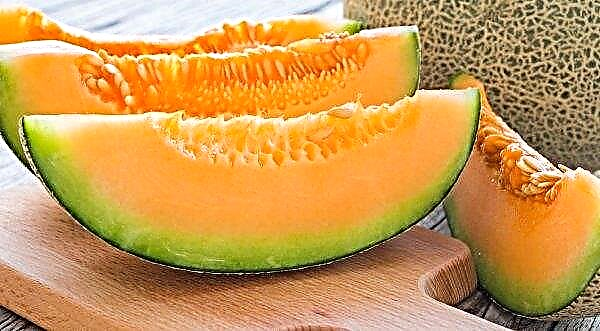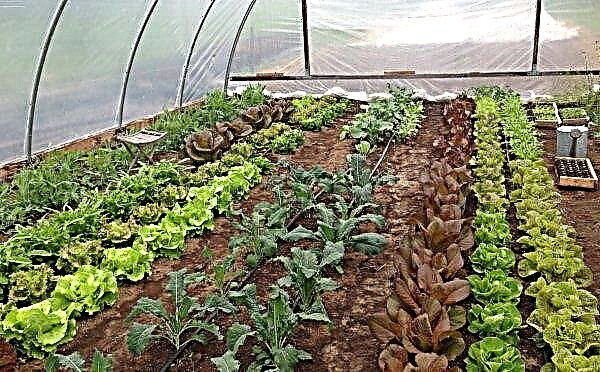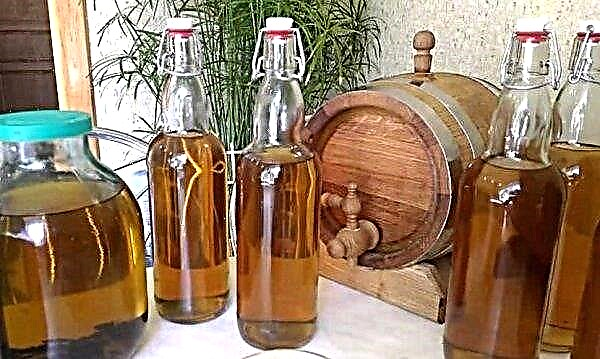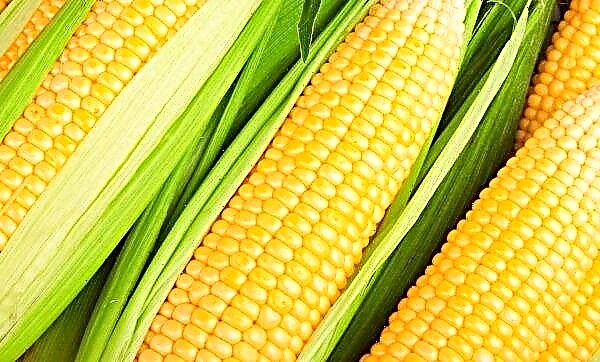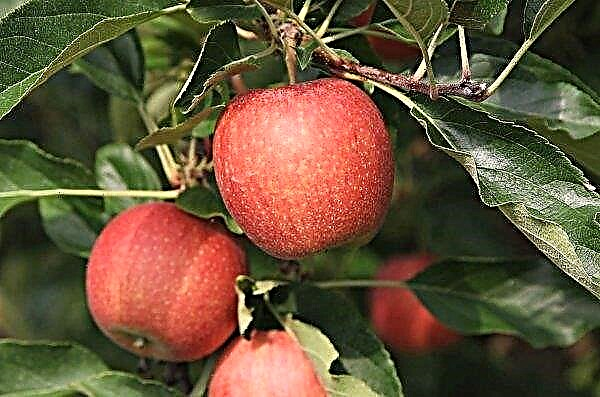Radish belongs to vegetables, in which the aboveground and underground parts are almost equivalent in terms of their use in food. The valuable properties of radish tops and methods of its use will be discussed later.
Is it possible to eat tops
If we take into account that the radish belongs to the Cabbage family, then even purely theoretically we can verify the edibility of the upper part of the plant. In practice, radish tops, due to the presence of mustard and essential oils, have a pleasant taste, as well as pronounced healing and cosmetic properties.
Did you know? We are accustomed to red on the outside and white inside the radish, but for a long time there have been varieties of this plant, the fruits of which are green on the outside and scarlet inside, as well as with white, brown, yellow, purple and raspberry surfaces.
The presence of a variety of nutrients in green radishes makes the tops not only possible, but also a desirable food product on a person’s table. Even children who are usually enthusiastic about spicy greens eat appetizing radish leaves. The greens of this vegetable can be fed degu and other similar pets.
The chemical composition of radish tops
By the set of useful substances and their concentration, radish greens (leaf and stem) surpasses the more popular underground part of the plant.
There are vitamins in the tops:
- AND;
- almost all of group B;
- WITH;
- E;
- TO;
- PP
Trace elements in the described product are presented:
- iron;
- iodine;
- fluorine;
- nickel;
- manganese;
- lithium;
- boron;
- zinc
- copper;
- cobalt;
- vanadium;
- chrome.
 There are many macrocells in it in the form of:
There are many macrocells in it in the form of:- sodium;
- magnesium
- potassium;
- chlorine;
- calcium
- phosphorus.
In addition, radish greens are saturated:
- sugars;
- vegetable protein;
- starch;
- essential oils;
- organic acids;
- carotene.
Properties of radish tops
Saturation with nutrients determines the properties of the green part of the radish that are favorable for the human body. Accordingly, the answer to the question of whether it is useful is unambiguously positive. Moreover, the product has much less contraindications than the underground part of the plant.
Benefit
- Especially noticeable radish tops contributes to:
- destruction of harmful bacteria and viruses in the body as a natural antibiotic;
- strengthening the immune system;
- increase the elasticity of blood vessels;
- lowering blood sugar, which is extremely important for diabetes;
- mitigation of the course of diseases of the urinary system and hemorrhoids;
- stimulation of brain activity;
- optimizing the functioning of the cardiovascular system;
- successful fight against rickets in children;
- improvement of digestive activity due to the presence of fiber;
- preventing the development of atherosclerosis;
- uplifting;
- tissue regeneration at the cellular level.
Did you know? Juice from a root crop such as radish is able to effectively eliminate bruises and painful effects of bruises if they moisten a handkerchief and apply to the affected area.
Harm and contraindications
- In addition to people suffering from individual intolerance to the product in question, radish greens are also not indicated for patients to use when:
- stomach ulcer;
- gastritis;
- exacerbation of gallstone disease;
- duodenal ulcer;
- increased acidity of the stomach.

Proper collection and storage of radish tops
For the sake of one leaf tops, radishes are practically not grown. For this reason, the collection and storage of radish greens have to be combined with the collection of root crops, adapting to it.
The radish is pulled out of the ground, holding the tops, so if it is subsequently intended for use, you should not crush the greens in your hand during this operation. There is another significant nuance: the harvested radish at first better maintains its condition if the tops are not removed from it .
But on the other hand, the green part itself, even if it is a large tops and it is sprayed with water, quickly loses freshness, after which the safety of root crops is sharply reduced. Therefore, most often, the tops are cut from root crops immediately after harvesting.
In its fresh form, it is most suitable for culinary use, and for long-term storage this part of the plant has to be dried, closed in grated and mixed with salt form in glass jars or frozen.
The last method, in which the maximum of useful substances is preserved, is carried out by grinding radish leaves and placing them in a hermetically sealed plastic bag in the freezer. In this form, the product is able to persist until the next harvest.
When dried, radish leaves retain much less vitamins, but still they contain a sufficient amount of valuable minerals and essential oils. Consider how to dry radish leaves. It should be borne in mind that they contain a lot of moisture, so they are best dried in an oven at a minimum temperature for 8 hours.
It should be borne in mind that they contain a lot of moisture, so they are best dried in an oven at a minimum temperature for 8 hours.
Important! So that when separating the green part from the root crop, not to harm both parts of the plant, the tops need not be cut off, but broken out, leaving a small piece of greenery on the root crop.
How to apply radish leaves
Radish greens, in addition to its use for gastronomic purposes, are widely used in folk medicine and cosmetology.
In folk medicine
Official medicine is not inclined to use the healing properties of radish tops, while traditional healers have accumulated sufficient experience in using this green in the fight against:
- vitamin deficiency;
- problems in the activity of the gastrointestinal tract;
- lack of appetite;
- constipation
- diabetes mellitus;
- hemorrhoids;
- problems in the biliary tract;
- edema;
- asthma
- eczema
- obese.
The product is also used to strengthen the immune system. Most often, traditional healers resort to infusions of radish greens, which have fortifying, anti-inflammatory and bactericidal properties. To make such a tool, you need 1 tbsp. l chopped radish greens, pour a glass of boiling water and insist for 60 minutes.
Most often, traditional healers resort to infusions of radish greens, which have fortifying, anti-inflammatory and bactericidal properties. To make such a tool, you need 1 tbsp. l chopped radish greens, pour a glass of boiling water and insist for 60 minutes.
The resulting infusion is taken for 4 days three times a day for a third of a glass after eating.
Cosmetic properties
The abundance of vitamins and minerals in radish leaves makes it possible to make very effective cosmetics from them at home. Their effectiveness is also due to the ability of radish tops to regenerate tissue at the cellular level, which allows you to rejuvenate the skin.
To make a nourishing mask for the skin from the upper part of the plant, you need:
- Grind well washed and dried tops.
- In 1 tbsp. chopped herbs add 7 drops of olive oil and 12 g of starch.
- Mix vigorously.
- Apply it for 10 minutes on the face.
- Then rinse with warm water and grease your face with the usual cream.
Important! Even in the refrigerator, the tops of radishes cannot be stored for more than 3 days.
To make a whitening mask, you must:
- Chopped herbs in the amount of 1 tbsp. add to 1 tbsp. kefir, in which 1 teaspoon of white clay was previously mixed.
- After vigorous stirring, apply the mixture on the face for 10 minutes.
- The procedure is recommended to be repeated weekly.

In cooking
Speaking about what can be prepared from the greens of the described plant, it should be emphasized that the culinary application of radish tops is diverse, as evidenced by numerous recipes. Most often it is used as an integral part of various salads.
In addition, from it:
- cooked vegetable soup, in which the tops replace the cabbage;
- make a filling for pies;
- prepare a dish resembling Caucasian cabbage rolls.
Also, the tops are fermented, dried for seasoning, and salted with dry and hot methods.
Radish salad

- Finely chop the tops.
- Blanch it for 5 minutes with beans in boiling water.
- Drain boiling water and rinse the mixture with cold water.
- Mix mustard powder with oil, adding pepper and salt to taste.
- Cut not very finely root vegetables of radish and basil.
- Mix with them a mixture of beans and radish greens.
- Pour the resulting composition with oil and sprinkle with chopped cheese.
Radish leaf cream soup

- Cut radishes into thin circles.
- Sprinkle them with sugar and let it marinate for 1 hour.
- In a saucepan with a small addition of olive oil, stew chopped shallots, seasoned with sage, thyme and rosemary.
- Put the diced potatoes there and fry the ingredients together.
- Add a small amount of vegetable broth to the pan.
- Bring the mixture to a boil and throw the well-washed radish leaves into it.
- After reaching the readiness of the products, grind them using an immersion blender, and then grind with a sieve.
- Dilute the resulting mass with the remaining hot broth to obtain the desired consistency.
- Salt to taste the resulting soup and put it in a warm place.
- Drain the marinade from the chopped and pickled radish root crop.
- Dry pieces of radish with a napkin and fry them in olive oil, bringing to a golden color.
- Pouring the resulting cream soup of radish greens on plates, garnish with mugs of toasted root vegetables and pepper to taste.
Today, more and more people are competently using radish greens - both to improve health and as a source of pleasure from the gastronomic properties of the product.

